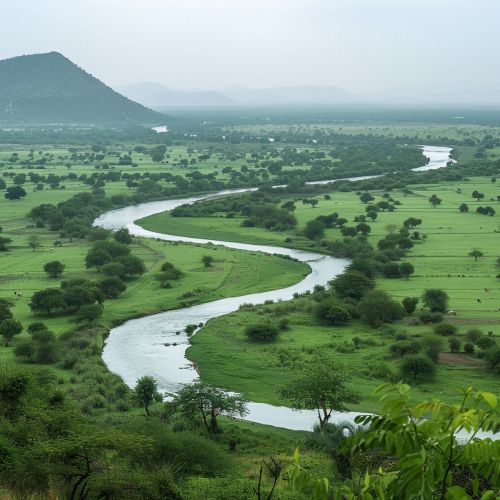Godavari River
Introduction
The **Godavari River** is one of the longest rivers in India, flowing across the central and southeastern regions of the country. It is often referred to as the "Dakshina Ganga" or "Ganges of the South" due to its significant cultural and spiritual importance. Originating in the Western Ghats, the river traverses a diverse array of landscapes and supports a wide range of ecosystems and human settlements along its course.
Geographical Overview
Source and Course
The Godavari River originates near Trimbak in the Nashik District of Maharashtra, at an elevation of approximately 1,067 meters above sea level. From its source, the river flows eastward for about 1,465 kilometers before emptying into the Bay of Bengal. Along its journey, the river passes through the states of Maharashtra, Telangana, Andhra Pradesh, Chhattisgarh, and Odisha.


Tributaries
The Godavari River has numerous tributaries that significantly contribute to its flow. Major tributaries include the Pravara, Purna, Manjira, Penganga, Wardha, Wainganga, Indravati, Pranhita, and Sabari. These tributaries play a crucial role in the hydrology and ecology of the Godavari basin.
Basin and Drainage
The Godavari basin is one of the largest river basins in India, covering an area of approximately 312,812 square kilometers. It encompasses a variety of terrains, including the Deccan Plateau, Eastern Ghats, and coastal plains. The basin is characterized by diverse climatic conditions, ranging from arid and semi-arid regions in the west to humid and tropical areas in the east.
Hydrology and Climate
Flow Regime
The flow regime of the Godavari River is highly seasonal, with significant variations in discharge throughout the year. The river experiences peak flows during the monsoon season (June to September), driven by heavy rainfall in the catchment area. During this period, the river often swells, leading to extensive flooding in the lower reaches. In contrast, the dry season (October to May) witnesses a substantial reduction in flow, affecting water availability for various uses.
Climate Influence
The climate of the Godavari basin is predominantly influenced by the Southwest Monsoon. The western part of the basin, particularly the Western Ghats, receives high rainfall, while the eastern regions experience relatively lower precipitation. The average annual rainfall in the basin ranges from 1,000 to 3,000 millimeters, with significant spatial and temporal variations.
Ecological Significance
Biodiversity
The Godavari River basin is home to a rich diversity of flora and fauna. The river supports various aquatic species, including fish, amphibians, and invertebrates. Notable fish species include the Indian major carps, catla, rohu, and mrigal. The riverine forests and wetlands along the Godavari provide critical habitats for numerous bird species, mammals, and reptiles.
Conservation Areas
Several protected areas and wildlife sanctuaries are located within the Godavari basin, aimed at conserving its unique biodiversity. Prominent among these are the Kawal Wildlife Sanctuary, Papikonda National Park, and Indravati National Park. These areas play a vital role in preserving the ecological integrity of the region.
Socio-Economic Importance
Agriculture
The Godavari River is a lifeline for agriculture in the regions it traverses. The fertile alluvial plains along the river are extensively cultivated, supporting the production of a variety of crops such as rice, sugarcane, cotton, and pulses. The river's water is harnessed for irrigation through an extensive network of canals and reservoirs, including the Nagarjuna Sagar Dam and the Polavaram Project.
Industry
The Godavari basin is also a hub for various industrial activities. The availability of water resources has facilitated the establishment of industries such as textiles, paper, chemicals, and food processing. Major industrial centers along the river include Nashik, Aurangabad, Rajahmundry, and Vijayawada.
Cultural and Religious Significance
The Godavari River holds immense cultural and religious significance for millions of people. It is considered sacred in Hinduism, and numerous temples and pilgrimage sites are located along its banks. The Kumbh Mela festival, held every twelve years in Nashik, attracts millions of devotees who come to take a holy dip in the river. Other important religious sites include Trimbakeshwar, Bhadrachalam, and Rajahmundry.
Environmental Challenges
Pollution
The Godavari River faces significant pollution challenges due to industrial effluents, agricultural runoff, and domestic sewage. The discharge of untreated wastewater into the river has led to the deterioration of water quality, posing risks to human health and aquatic life. Efforts are being made to address these issues through initiatives such as the National River Conservation Plan and local government interventions.
Deforestation and Land Degradation
Deforestation and land degradation in the Godavari basin have exacerbated soil erosion and sedimentation in the river. The loss of forest cover, particularly in the Western Ghats, has disrupted the natural hydrological cycle, affecting water availability and quality. Sustainable land management practices and reforestation efforts are crucial to mitigate these impacts.
Climate Change
Climate change poses a long-term threat to the Godavari River and its basin. Changes in precipitation patterns, increased frequency of extreme weather events, and rising temperatures can alter the river's flow regime and exacerbate water scarcity. Adaptive measures, including improved water management and climate-resilient infrastructure, are essential to address these challenges.
